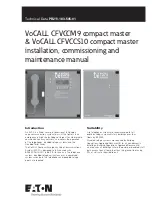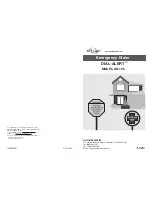
11
Technical Data
PR211-183-505-01
VoCALL CFVCCM9 compact master
EATON
www.eaton.com
Pressing TICK again will show the settings menu, with the
network option currently selected. If this is no, the CFVCCM9 unit
will not communicate with the S10, and will be effectively isolated.
If yes then the M9 unit will access the S10 slave. Use the naviga-
tion keys to toggle between the options, and press TICK to move
onto supervisor.
Network settings
Network >No
Supervisor:No
Address:1 :Next
The Supervisor Menu allows this M9 to view the complete
system (up to 32 M9 masters) a system can comprise each
master must have its’ own unique ID. These ID numbers range
from 1 to 32. This node ID is used to uniquely identify the master
unit. Use the navigation keys to select the node ID for this master
unit, and press TICK to move to the next option.
We must now tell the system how many M9’s should be present
on the system:
Network
Settings
>Supervisor present
Master present
Scroll to the supervisor addresses option and press TICK.
Supervisor present
1=Y 2>N 3:N 4:N
:Next
Using the up and down keys to toggle yes or no and the TICK key
to move to the next value. Set the valid addresses for masters
present on the system. When you reach Next, press TICK to take
you back to the start. Save will store and Quit will leave as usual.
The = sign appears at the address you set in the network configu-
ration menu as this is your address.
Master present :Next
1>Y 2:N 3:N 4:N
5:Y 6:N 7:N 8:N
9:Y 10:N 11:N :Next
Using the up and down keys to toggle yes or no and the TICK key
to move to the next value. Set the valid addresses for supervisors
present on the system. When you reach Next, press TICK to take
you to page 2. Save will store and Quit will leave as usual.
Operation
All conversations on the VoCALL Compact unit are under the
command of the CFVCCM9 master handset.
BS5289 Pt9 envisages the majority of calls to be made by lifting
the handset of an outstation (Type A) or pressing the call button
on a disabled refuge (Type B).
Receiving a call
When a handset is lifted or the call button is pressed on a
Type B unit, the phone on the master handset will ring and the
name of the calling outstation will appear on the LCD display (all
outstation lines can be given a unique 18 character name to
identify themselves such as “Floor 1 Riser E”).
If User access is disabled, then the login page is shown
instead when a call is received. Log in as either Manager or
Engineer to continue onto the call page where the calling
outstation is displayed.
The operator can then lift the master handset and connect to
the calling outstation by pressing the TICK key. If more than one
outstation is calling, all calling outstations show in the display, and
may be scrolled through with the navigation buttons, connected
using the TICK key, or if already connected placed on hold using
the TICK key a second time.
If the CFVCCM9 master handset wishes to ring an outstation,
they may do this by scrolling through the names in the directory
and pressing TICK over the outstation they want.
If the outstation is defined as a pull cord (disabled toilet alarm),
then a continuous tone is heard from the buzzer instead of the
master handset ringing when the disabled toilet alarm is activated.
This tone is silenced when the Master Handset goes off hook.
This tone can also be silenced by pressing the TICK key. The tone
will remain silent for 4 minutes, whereupon it will recommence.
This tone signifies that the toilet alarm has been activated, and it
can occur simultaneously with the Master Handset ringing due to
an incoming call from a Type A or Type B handset.
Making a call
Lift the handset on the master handset, then press the * key to
scroll the display to the directory page. If user access is disabled,
the log in page is shown instead. Log in as Manager or Engineer
to continue onto the directory page. Once in the directory use the
up and down keys navigation to select the outstation name you
require, and then press TICK to call. The outstation will connect
when answered.
Calls cannot be initiated to any extension that is defined as a pull
cord (disabled toilet alarm).
Ending or holding a call
Both call types can be ended by pressing the TICK key
on the outstation line you no longer wish to call (if the bell
symbol is shown).
Pressing TICK while an outstation is speaking or is off hook will
place the line on HOLD (the symbol of an off hook phone is
shown), you can talk to this line again by scrolling to it and
pressing TICK again.
User access
Calls cannot be received nor initiated if user access is disabled
until logged in as either Manager or Engineer. User access is to be
disabled if the panel is located in a public area.
Once logged in, the panel can be used freely. However, there is
an automatic log out after 4 minutes of inactivity. Inactivity is all
handsets on hook, and the panel is not used.
If accept is pressed on status page, the Manager/Engineer menu
is shown without the need for a further log in action.
If user access is enabled, then calls can be received and initiated
without being logged in as Manager or Engineer.
Maintenance
It is a requirement of BS5839pt9 that a maintenance
agreement be in place for the EVCS, the maintenance
schedule should be as follows.
Weekly:
Lift a different handset each week and make a call
to the Master. Repeat each week until all points are
tested. Record results in the site log.
Monthly
:
Test one outstation by lifting the handset, followed
by the master calling that outstation. Record results
in the site log.
Quarterly:
Engineer call to check system operation.
Yearly:
Engineer call to check system operation and check
battery health.
5 Yearly:
Engineer call to check system operation and replace
the batteries.































